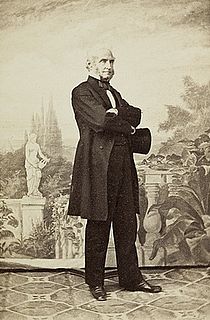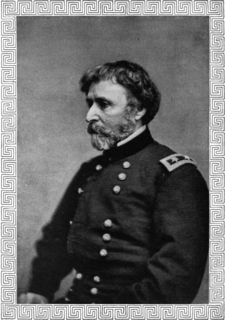
In the context of the American Civil War (1861–65), the border states were slave states that did not secede from the Union. They were Delaware, Maryland, Kentucky, and Missouri, and after 1863, the new state of West Virginia. To their north they bordered free states of the Union and to their south they bordered slave states of the Confederacy, with Delaware being an exception to the latter.

The Battle of Wilson's Creek, also known as the Battle of Oak Hills, was the first major battle of the Trans-Mississippi Theater of the American Civil War. It was fought on August 10, 1861, near Springfield, Missouri. Missouri was officially a neutral state, but its governor, Claiborne Fox Jackson, supported the South and secretly collaborated with Confederate troops.

Nathaniel Lyon was the first Union general to be killed in the American Civil War. He is noted for his actions in Missouri in 1861, at the beginning of the conflict, to forestall secret secessionist plans of the governor Claiborne Jackson.

Claiborne Fox Jackson was an American politician of the Democratic Party in Missouri. He was elected as the 15th governor of Missouri, serving from January 3, 1861, until July 31, 1861, when he was forced out by the Unionist majority in the legislature, after planning to force secession of the state.

The Camp Jackson affair, also known as the Camp Jackson massacre, occurred during the American Civil War on May 10, 1861, when a volunteer Union Army regiment captured a unit of secessionists at Camp Jackson, outside the city of St. Louis, in the divided slave state of Missouri.
During the American Civil War, the secession of Missouri from the Union was controversial because of the state's disputed status. Missouri was claimed by both the Union and the Confederacy, had two rival state governments, and sent representatives to both the United States Congress and the Confederate Congress.

The Battle of Carthage, also known as the Engagement near Carthage, took place at the beginning of the American Civil War on July 5, 1861, near Carthage, Missouri. The experienced Colonel Franz Sigel commanded 1,100 Federal soldiers intent on keeping Missouri within the Union. The Missouri State Guard was commanded by Governor Claiborne F. Jackson himself and numbered over 4,000 soldiers led by a hero of Mexico, Sterling Price, along with 2,000 unarmed troops who did not participate in the battle.

The First Battle of Boonville was a minor skirmish of the American Civil War, occurring on June 17, 1861, near Boonville in Cooper County, Missouri. Although casualties were extremely light, the battle's strategic impact was far greater than one might assume from its limited nature. The Union victory established what would become an unbroken Federal control of the Missouri River, and helped to thwart efforts to bring Missouri into the Confederacy.

The St. Louis Arsenal is a large complex of federal military weapons and ammunition storage buildings operated by the United States Air Force in St. Louis, Missouri. During the American Civil War, the St. Louis arsenal's contents were transferred to Illinois by Union Captain Nathaniel Lyon, an act that helped fuel tension between secessionists and those citizens loyal to the Federal government.
The Price–Harney Truce was a document signed on May 21, 1861, between United States Army General William S. Harney and Missouri State Guard commander Sterling Price at the beginning of the American Civil War.

The Missouri State Guard (MSG) was a military force established by the Missouri General Assembly on May 11, 1861. While not a formation of the Confederate States Army, the Missouri State Guard fought alongside Confederate troops and, at various times, served under Confederate officers.

Hamilton Rowan Gamble was an American jurist and politician who served as the Chief Justice of the Missouri Supreme Court at the time of the Dred Scott case in 1852. Although his colleagues voted to overturn the 28-year precedent in Missouri of "once free always free," Gamble wrote a dissenting opinion. During the American Civil War, he was appointed as the Governor of Missouri by a Constitutional Convention after Union forces captured the state capital at Jefferson City and deposed the elected governor, Claiborne Jackson.

During the American Civil War, Missouri was a hotly contested border state populated by both Union and Confederate sympathizers. It sent armies, generals, and supplies to both sides, was represented with a star on both flags, maintained dual governments, and endured a bloody neighbor-against-neighbor intrastate war within the larger national war.

Thomas Caute Reynolds was the Confederate governor of Missouri from 1862 to 1865, succeeding upon the death of Claiborne F. Jackson after serving as lieutenant governor in exile. In 1864 he returned to the state, but was forced back into exile after the Battle of Westport.
The Missouri Constitutional Convention of 1861–1863 was a constitutional convention held in the state of Missouri during the American Civil War. The convention was elected in early 1861, and voted against secession. When open fighting broke out between Pro-Confederate governor Claiborne Fox Jackson and Union authorities, and Union forces occupied the state capital, the convention formed a provisional state government, and functioned as a quasi-legislature for several years. The convention never did produce a new constitution; that task was delegated to a new convention, elected in 1864.
In the American Civil War the Home Guard or Home Guards were local militia raised from Union loyalists.
The Missouri Volunteer Militia (MVM) was the state militia organization of Missouri, before the formation of the Missouri State Guard in the American Civil War.

The Frémont Emancipation was part of a military proclamation issued by Major General John C. Frémont (1813–1890) on August 30, 1861 in St. Louis, Missouri during the early months of the American Civil War. The proclamation placed the state of Missouri under martial law and decreed that all property of those bearing arms in rebellion would be confiscated, including slaves, and that confiscated slaves would subsequently be declared free. It also imposed capital punishment for those in rebellion against the federal government.

The Confederate government of Missouri was a continuation in exile of the government of pro-Confederate Governor Claiborne F. Jackson. It existed until General E. Kirby Smith surrendered all Confederate troops west of the Mississippi River at New Orleans, May 26, 1865.

The Minutemen was a secessionist paramilitary organization in St. Louis, Missouri in the early months of 1861. Many members joined the 2nd Regiment of the Missouri Volunteer Militia, and after May 10, 1861 the Missouri State Guard or the Confederate States Army.














